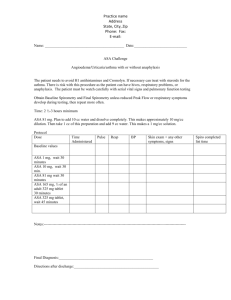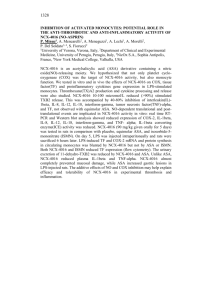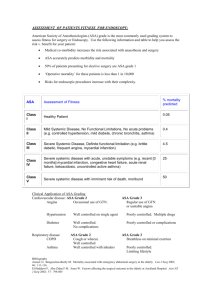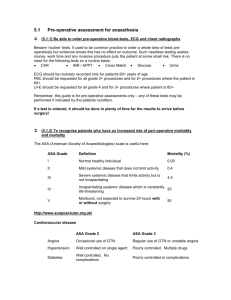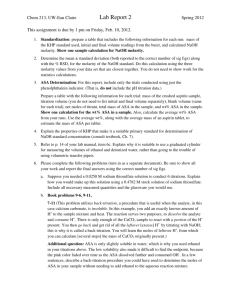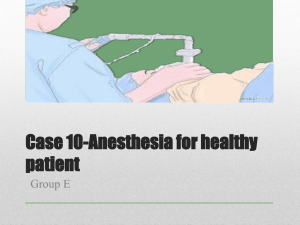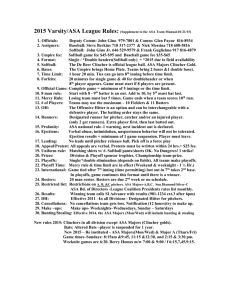Unit 2 analgesics and anti inflammatory
advertisement
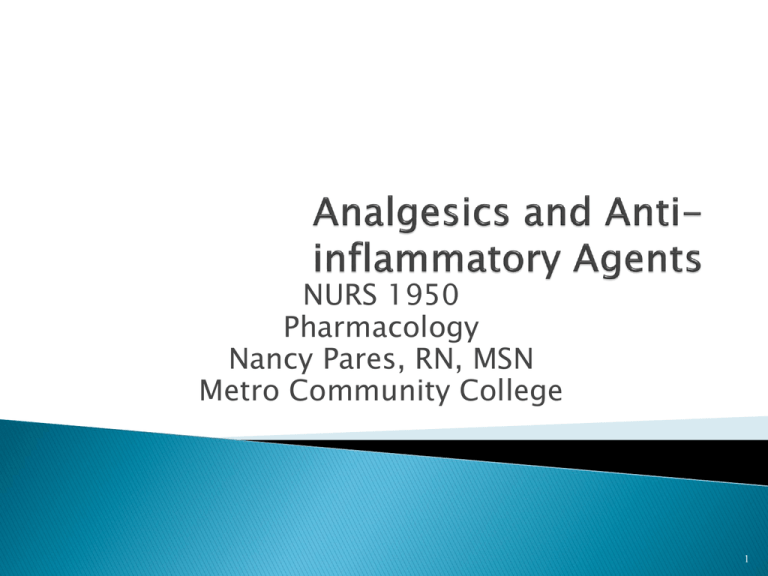
NURS 1950 Pharmacology Nancy Pares, RN, MSN Metro Community College 1 Pain is: Pain tolerance is: 2 Objective 2: Identify the factors which affect the individual’s response to pain 3 4 What are the assessments? What is included in a pain history? 5 Objective drugs 4: Describe scheduled 6 Schedule abuse I: high potential for ◦ No accepted medical use in US Schedule II: ◦ high potential for abuse ◦ Opiate analgesics 7 Schedule III: lower potential for abuse than schedule II. ◦ Tylenol with codeine Schedule IV: lower potential for abuse than schedule III. ◦ Librium, Valium 8 Schedule abuse V: lowest potential for ◦ Usually antidiarrheal and antitussive ◦ Lomotil ◦ Robitussin A-C 9 What are analgesics? 10 Bind CNS to opiate receptors in the ◦ This inhibits transmission of pain impulse and alters pain perception ◦ Also produce euphoria 11 Some are opioid agonists ◦ What is an agonist? Some are agonist-antagonists 12 Side effects of opioids ◦ N/V ◦ Constipation ◦ Respiratory depression ◦ Dependence ◦ Tolerance 13 When the opioids are discontinued: ◦ Sweating, restlessness, diarrhea 14 Signs and symptoms of overdose ◦ Respirations under 12/minute ◦ Pin-point pupils ◦ Coma What drug can be used to reverse these effects? Why does it work? 15 Objective 7: Compare the many effects of morphine sulfate (MS) and meperidine (Demerol) 16 17 MS ◦ Oral ◦ Subc ◦ IV ◦ IM ◦ Rectal ◦ Sublingual ◦ “mother” of all narcotics Demerol ◦ Oral ◦ Subc ◦ IV ◦ IM 18 MS 5-20 mg dose q 4 hr 10-60 min onset Longer duration of action than Demerol Demerol ◦ 50-100 mg q 34 hr ◦ 10-45 min onset ◦ Shorter duration of action than MS 19 Assessment of pain Assessment of respirations MS can be used in cancer pain Meperidine (Demerol) metabolite is normeperidine: causes hallucinations 20 What narcotic agents have you given? 21 Many narcotic agents available Given by every route Some are only in oral form 22 Some narcotic analgesics are ◦ Hydrocodone + acetaminophen (Vicodin) ◦ Fentanyl (Duragesic) ◦ Oxycodone + ASA (Percodan) 23 A client is receiving MSContin q 12 hr-30 mg At the next dose time, there is break through pain. Can the client also have the MSIR dose? 24 Narcotics work in the CNS and affect the nociceptors (nerve endings) and the neurotransmitter pathways of pain transmission Acetaminophen, ASA, and the NSAIDs work in the periphery and interfere with prostaglandins 25 Nonopioid drugs are also readily available (OTC) and inexpensive Are antipyretic and ASA and some NSAIDs have antiplatelet activity No tolerance or dependence is caused as is the case with opiates 26 Double lock Sign out Use non-drug interventions Assess pain Give meds before pain severe Don’t under treat pain 27 Objective 11describe the use of salicylates 28 Peripherally acting Interfere with synthesis of prostaglandins ◦ What are prostaglandins? 29 Acetylsalicylic acid (aspirin, ASA) used over 100 years Analgesic Antipyretic Anti-inflammatory Antiplatelet 30 What ◦ As ◦ As ◦ As ◦ As are the doses for ASA? analgesic anti-inflammatory antipyretic antiplatelet 31 Contraindicated if: on anticoagulants if gastric ulcer pregnancy children with viral infections Hypersensitive—teach client to read OTC labels 32 Client must take adequate fluids If GI upset, take with food or antacid ◦ Options: buffered ◦ enteric coated 33 What does it mean when the label says the ASA is buffered? What does enteric coating mean? ◦ Can EC drugs be crushed or chewed? 34 ASA can cause false + for glycosuria SE: tinnitus and vertigo with high doses Store ASA in closed, child proof container Overdose needs prompt treatment 35 Objective 13: identify the signs of salicylate poisoning 36 37 Acetaminophen (Tylenol) ◦ Nonopioid analgesic ◦ Antipyretic ◦ Available as a liquid 38 Disadvantage of Tylenol: ◦ Hepatotoxicity (over 4 gm/day) ◦ Nephrotoxicity 39 Objective 15: list some nonnarcotic analgesics 40 Buprenophine HCl (Buprenex) Butophanol tartrate (Stadol) Pentazocine HCl (Talwin) Ibuprofen (Motrin) Naproxin (Aleve) 41 If your client is taking Percocet and also has Tylenol ordered, what precautions will you take? 42 Objective 16: identify some nonsteroidal anti-inflammatory agents 43 Nonsteroidal antiinflammatory agents modify inflammation response ◦ Inhibit prostaglandin synthesis ◦ Includes Aspirin as well as Motrin, Aleve, indomethacin (Indocin), oxaprozin ( Daypro), ketoralac (Toradol) Toradol only one given IM, IV 44 New NSAIDs are the COX-2 inhibitors Vioxx off the market 2004 Celecoxib (Celebrex) and its cousin Bextra under review 45 46 Advantage of COX-2 inhibitors: ◦ Less GI bleeding than other NSAIDs ◦ Once a day or BID dosing Disadvantages: ◦ Can’t use if allergic ◦ expensive 47 Gouty arthritis: ◦ caused by uric acid crystals ◦ Deposit in joints and subq tissue ◦ Treat ASAP when acute attack occurs ◦ Treat acute attack with colchicine IV, oral 48 think it prevents migration of granulocytes to inflamed area so no lactic acid released 49 Adverse effects of colchicine ◦ N/V ◦ Diarrhea ◦ GI bleeding ◦ Neuritis ◦ Myopathy ◦ Alopecia ◦ Bone marrow depression 50 NSAIDs may be used for inflammation, pain and fever Two other types of drugs used for gout ◦ Uricosurics increase excretion of uric acid 51 Adverse effects: ◦ kidney stones can develop Examples: probenecid (Benemid) and sulfinpyrazone (Anturane) 52 With Benemid keep urine alkaline No ASA Anturane works like Benemid but also affects clotting time ◦ Can cause GI bleeding, skin rash and blood dyscrasias 53 Allopurinol (Zyloprim) prevents formation of uric acid ◦ Usually 300 mg dose 1x daily ◦ Can be given with colchicine or a NSAID ◦ SE of allopurinol: skin rash, hepatotoxicity 54 Assessment Nursing diagnoses ◦ Pain ◦ Chronic pain ◦ Risk for injury ◦ Deficient knowledge 55 Goals ◦ Pain to be controlled ◦ Chronic pain will be controlled ◦ Demonstrate a proactive approach to pain management ◦ No injury from pain management ◦ Verbalize knowledge ◦ Implement plan 56 Use pain-relieving measures Pain history Be proactive Don’t under treat Record pain relief Assess respirations Assess nausea, vomiting and decreasing BP 57 Acetaminophen: no substitute for ASA If allergic to ASA, avoid some NSAIDs Indomethacin: ulcerogenic, aggravate epilepsy, psychiatric disorders 58 Nursing for anti-gout medications Assess those on colchicine Start colchicine at first sign Avoid those things that aggravate gout: High-fat diet, purine-rich foods, thiazide diuretics, liver extracts, nicotinic acid, penicillin, cancer chemotherapeutic agents, levodopa, ethambutol, egotamine 59
